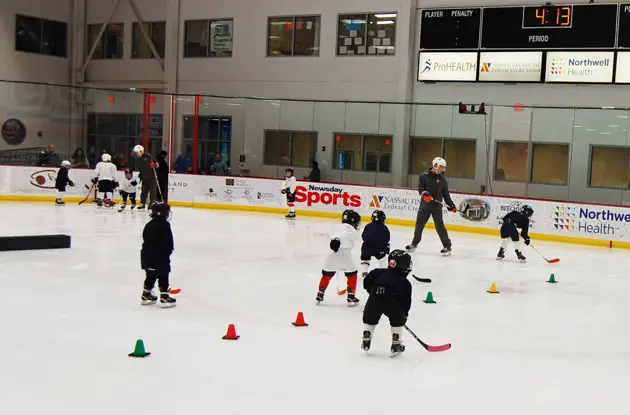For most of my childhood, my extracurricular schedule consisted of riding my bike to the local YMCA every Saturday morning for a swimming lesson. I’m pretty sure my mom and dad never asked themselves if they were scheduling too much or too little for me. And yet it’s a question parents these days seem to grapple with constantly.
I always thought finding the right balance with my own children would be clear, but I can’t deny the pressure I sometimes feel when I hear about my kids’ friends and their weekly schedules: acting class, guitar, gymnastics, tennis, dance, Mandarin. To shed some light on this issue, I turned to local experts who support parents as they navigate matters like this.
The Research on After-School Activities
To discuss the balance between scheduled activities and unscheduled me time for kids, it’s important first to ask: Are today’s kids actually overscheduled—or does it just feel that way?
A recent paper in the journal Social Policy Report reviewed the research and found more than 80 percent of American children take part in some extracurricular activity, including sports, lessons, or clubs. Approximately 7 million of those are enrolled in after-school programs and many more participate in clubs and organizations such as Boys & Girls Clubs of America and Girls Inc., according to the report.
Even though those numbers may seem high, the same report shows children and adolescents spend an average of only five hours per week participating in organized activities. So, although extracurricular activities get a lot of attention, other activities—screen time, chores, spending time with friends and family, working, and doing homework—occupy as much (and often more) time than organized activities. In other words, it may make more sense to worry about your child’s screen time than about the hours he spends at after-school programs.
There are, however, cases where overscheduling poses problems for kids. The same research suggests there may be a point of diminishing returns for a small number of young people with very high levels of involvement—meaning, some kids who participate in a multitude of extracurricular activities may see fewer advantages as they take on more and more. For instance, the educational benefits of playing sports seem to level off when kids participate in more than two competitive team sports.
Danis Copenhaver, M.D., F.A.A.P., a pediatrician at South Slope Pediatrics in Brooklyn, looks for telltale signs to make sure her young patients aren’t overscheduled. “I make a point to ask every patient and family about mealtimes and sleep,” she says. “A huge red flag for me is if meals are always eaten on the go and if bedtime is inconsistent or very late. In pre-teens and teenagers, I try and assess if they are enjoying the activities they are involved in. Sometimes they will answer honestly in the exam room and it’s the first time the parents are hearing about it. That can lead to a discussion about prioritizing time out of school for family, friends, sports, and activities.”
Overall, however, concerns about overscheduling seem to be overblown. Despite what we so often hear in the media, the research shows that only a small number of young people (between 3 and 6 percent) are very highly scheduled, spending 20 or more hours a week taking part in these activities. The same research also points to evidence that kids who participate in organized activities do better than those who don’t. These young people are more likely to have higher academic achievement, finish school, do well in college, be well-adjusted, smoke less, use drugs less often, and interact more with parents.
The Benefits of Downtime for Kids
Even if kids may not, for the most part, be overscheduled, there are many studies emphasizing the pluses of unscheduled free time for children as well as adults. A 2012 report by Mary Helen Immordino-Yang of the University of Southern California showed that when we are resting, our brains are not actually idle and downtime is essential to many of our mental processes. The report examined related research showing this relaxed time is an opportunity for the brain to make sense of what it has recently learned.
Kids need to play and explore, says Sharon Peters, who founded the Brooklyn-based marriage and family counseling practice Parents Helping Parents. She is a big proponent of building downtime into a family’s schedule. For more than 20 years, she has been supporting parents as they raise their children. She also draws from her own personal experiences as a mother of five children, several of whom have special needs. “All group settings or one-on-one lessons with a teacher are demanding in ways that individual time isn’t,” she says.
Young kids can’t simply roam the streets alone, Peters notes, but it’s essential to fit into their schedules the type of play that encourages exploration and independence. “A great way to incorporate this for younger children is finding a safe space for them to wander and make decisions on their own,” she says. Her comment rings true for me personally, as I’ve noticed my 2-year-old is at his most relaxed and engaged when he is wandering through Prospect Park with me following a few feet behind him.
Downtime benefits kids of all ages, according to Dr. Copenhaver. “In younger children ages 2-5 unstructured play time encourages imagination and cooperation. It can also allow them time to rest and recharge, avoiding becoming overstimulated and cranky,” she says.
Me time also has specific benefits for older children. “In school-aged kids, I find that non-scheduled downtime allows them to more deeply explore their likes and develop their talents,” Dr. Copenhaver says. “Some kids develop a love of reading, others find that they still enjoy playing at the park, while others take the time to participate in preparing meals for their family.” She adds that in teens, stress levels decrease and sleep duration and quality usually benefit first from non-scheduled down time.
Finding the Right Balance
Given what we know about the positives of extracurricular activities and also the benefits of downtime, how do we go about finding what works for us? Here are some tips for ensuring your kids experience the right mix of enriching activities and nourishing downtime.
Create a schedule that works for your family. Because many children spend too much time using mobile devices and watching TV, the American Association of Pediatrics recommends maintaining at least one hour of physical activity a day and limiting screen time to two hours a day, according to Melanie Wilson-Taylor, M.D., F.A.A.P., also of South Slope pediatrics. “Oftentimes parents are busy with work or taking care of younger children and there can be pressure to make sure that kids are kept busy,” she says. “Many parents often feel the need to compete and make sure their child has access to every extracurricular activity in order to be a better candidate for the next level of school.”
Carefully consider what activities are right for your child. Dr. Wilson-Taylor recommends parents ask their child if she enjoys the activity and to consider whether there are true benefits—academic, social, personal development—in it. She cautions that sometimes the amount of time a child spends in an activity is reasonable but the type of activity may not fit the personality of the child. Parents should consider whether their child prefers group or individual activities, for instance, or whether the child will experience undue anxiety of performing in an end-of-year production or recital.
“Parents should also be mindful about how extracurricular activities affect the behavior and self-worth,” Dr. Wilson-Taylor says. “If the child is focused on always winning and values themselves based on their ability to succeed in the activity, caregivers should re-evaluate the importance of that activity.” One good rule of thumb she tells her patients: Due to a limited attention span, structured activities for children younger than 6 should be limited to 30 minutes at a time. Older children can tolerate activities that are an hour or two.
Look out for the red flags. According to Dr. Wilson-Taylor, temperament and age play a big part in judging whether a child is overscheduled. Some children like participating in activities outside of school or on the weekends and thrive on constantly doing something. Other children are homebodies or prefer unstructured activities. She cautions that “an overscheduled child has more tantrums prior to the activity, may take a long time to get ready, and may outright say ‘no’ to going. Older children may exhibit poor sleep patterns the night before in anticipation of participating in the event the next day. They also may seem more isolated from friends or family because they are always ‘doing something.’”
Parents should be concerned if they notice a child is clingier to caregivers, his grades are dropping, or her homework is getting squeezed into small gaps of free time—in the car, on the bus, waking up early before school. “If not attended to, young kids communicate discomfort one way or the other and raise the flag. This could be acting out in school or more tantrums at home,” Peters says.
Children may also exhibit stress-induced physical symptoms, some of which can mimic actual illness. “When a child’s day is scheduled down to the minute, they can become stressed, and sometimes manifest physical symptoms of that stress,” Dr. Copenhaver says. “Stomach aches, headaches, and fatigue are common symptoms that children present to my office with, and the problem is sometimes an overloaded schedule without enough down time.” In her practice, she also sees teens complaining of fatigue, and often finds out they are sleeping fewer than five hours a night because of their busy school and after-school schedules.
Trust your gut. “Like everything connected to parenting,” Peters says “this issue is very individual to each family.” Ultimately, she says, parents know their children—and since each situation and child is different, parents must rely on their instincts to decide when their child needs fewer after-school activities and more me time.
The bottom line: You probably don’t need to worry that your child is overscheduled or that the number of activities in which he participates will have a negative impact on him. However, me time remains an essential part of everyone’s life and plays an important role in children’s development—so make sure to schedule some unscheduled time into your child’s life regularly.
This is the second in a two-part series about the importance of downtime. Read the previous article, about me time for moms.
RELATED: Find the best after-school programs for your child.
Get all the local kids’ activities sent to your in-box weekly.





















